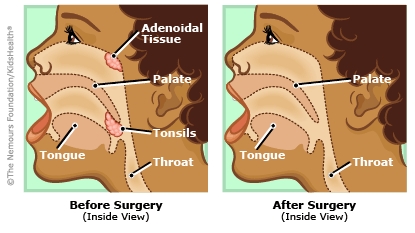- Home
- Humana Medicaid
- Kentucky Medicaid
- Medicaid extras
- Health and wellness
- Parents Home
- Para Padres
- A to Z Dictionary
- Allergy Center
- Asthma
- Cancer
- Diabetes
- Diseases & Conditions
- Doctors & Hospitals
- Emotions & Behavior
- First Aid & Safety
- Flu (Influenza)
- Food Allergies
- General Health
- Growth & Development
- Heart Health & Conditions
- Homework Help Center
- Infections
- Newborn Care
- Nutrition & Fitness
- Play & Learn
- Pregnancy Center
- Preventing Premature Birth
- Q&A
- School & Family Life
- Sports Medicine
- Teens Home
- Para Adolescentes
- Asthma
- Be Your Best Self
- Body & Skin Care
- Cancer
- Diabetes
- Diseases & Conditions
- Drugs & Alcohol
- Flu (Influenza)
- Homework Help
- Infections
- Managing Your Weight
- Medical Care 101
- Mental Health
- Nutrition & Fitness
- Q&A
- Safety & First Aid
- School, Jobs, & Friends
- Sexual Health
- Sports Medicine
- Stress & Coping
Adenoids and Adenoidectomy
What Are Adenoids?
Adenoids are a patch of tissue that sits at the very back of the nasal passage. Like tonsils, adenoids help keep the body healthy by trapping harmful and viruses that we breathe in or swallow.
Adenoids (pronounced: AD-eh-noyds) do important work as infection fighters for babies and young children. But they become less important as we get older and the body develops other ways to fight germs. Adenoids usually begin to shrink after about age 5 and often practically disappear by the teen years.
What Are Enlarged Adenoids?
Because adenoids trap germs that enter the body, adenoid tissue sometimes temporarily swells (becomes enlarged) as it tries to fight an infection. Allergies also can make them get bigger.
The swelling sometimes gets better. But sometimes, adenoids can get infected (this is called adenoiditis). If this happens a lot, a doctor might recommend they be removed. Often, tonsils and adenoids are surgically removed at the same time.
What Are the Signs & Symptoms of Enlarged Adenoids?
Someone with enlarged adenoids might:
- have trouble breathing through the nose
- breathe through the mouth (which can lead to dry lips and mouth)
- talk as if the nostrils are pinched
- have noisy breathing ("Darth Vader" breathing)
- have bad breath
- stop breathing for a few seconds during sleep (obstructive sleep apnea), which can lead to snoring and disturbed sleep
- have frequent or chronic (long-lasting) nose or sinus infections
- have ear infections, middle ear fluid, and hearing loss
How Are Enlarged Adenoids Diagnosed?
If your doctor thinks you have enlarged adenoids, he or she might:
- ask you how things feel in your ears, nose, and throat, and then examine these areas
- feel your neck near your jaw
To get a really close look, the doctor might order X-rays or look into the nasal passage with a tiny telescope.
If an infection is suspected, your doctor may prescribe oral antibiotics. Nasal steroids (a liquid that is sprayed into the nose) might be prescribed to help reduce swelling in the adenoids.
What's an Adenoidectomy?
A doctor may recommend surgical removal of enlarged or infected adenoids if they're bothersome and medicine is not controlling the problem. This procedure is called an adenoidectomy (pronounced: ad-eh-noy-DEK-teh-me).

Having adenoids removed is especially important when repeated infections lead to sinus and ear infections. Badly swollen adenoids can interfere with how the body ventilates the middle ears. This can sometimes lead to infections or temporary hearing loss.
What Happens During an Adenoidectomy?
During an adenoidectomy:
- The surgery is done in an operating room.
- The patient gets general anesthesia. This means the patient is "asleep" during the operation, with no sensations, feeling of pain, awareness, movement, or memory of the surgery. Heart rate, breathing, and other body functions are watched to be sure the person stays safe and healthy during the operation.
- The surgery usually takes 20–30 minutes.
- The surgeon can get to the adenoids (and tonsils if needed) through the patient 's open mouth — there's no need to cut any skin.
After an adenoidectomy, the patient will wake up in the recovery area. In most cases, a person can go home the same day of the surgery.
How Can I Feel Better?
The typical recovery after an adenoidectomy often involves several days of mild pain and discomfort, including sore throat, stuffy nose, and sometimes an earache.
In less than a week after surgery, everything should return to normal. There are no stitches to worry about, and the area where the adenoids were will heal on its own.
When Should I Call the Doctor?
Call the doctor if you:
- develop a fever
- vomit after the first day or after taking medicine
- have neck pain or neck stiffness that doesn't go away with pain medicine
- have trouble moving your neck
- can't drink
- aren't peeing at least once every 8 hours
Get medical care right away if you:
- have blood dripping out of the nose or coating the tongue for more than 10 minutes
- have bleeding after the first day
- vomit blood or something that looks like coffee grounds
What Else Should I Know?
Even though the adenoids are part of the immune system, removing them doesn't affect the body's ability to fight infections. The immune system has many other ways to fight germs.

© 1995- The Nemours Foundation. KidsHealth® is a registered trademark of The Nemours Foundation. All rights reserved.
Images sourced by The Nemours Foundation and Getty Images.